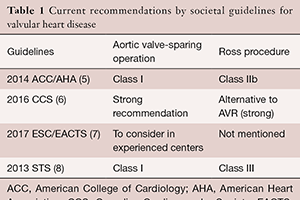The Ross procedure and valve-sparing root replacement procedures in the adult patient: do guidelines follow the evidence?
Abstract
Prosthetic aortic valve replacements have long been the mainstay of valvular surgery due to their favorable outcomes and low operative complexity. Yet, mechanical valves require lifelong anticoagulation, whereas bioprosthetic valves increase the risk for earlier and more frequent reoperation. Alternative reconstructive techniques have been proposed to address these challenges. These include valve-sparing root replacement procedures if the native aortic valve can be salvaged, and the Ross procedure, which nearly eliminates prosthetic valve-related thromboembolism, anticoagulation-related hemorrhage and endocarditis. Both procedures are technically more complex and thus subject to surgeons’ volume and expertise compared to conventional aortic valve replacements. However, they are associated with more favorable outcomes compared to aortic valve replacements if performed by experienced surgeons, especially in younger patients. Nevertheless, despite the growing high-quality literature supporting both procedures, existing multi-society guidelines fail to acknowledge the strength of evidence in support of valve-sparing root replacement procedures and the Ross procedure. In this review, we summarize the existing long-term evidence for the use of each procedure, describe the current guidelines for the treatment of aortic valve pathology, and propose the reevaluation of guidelines based on the available clinical evidence.
Cover






